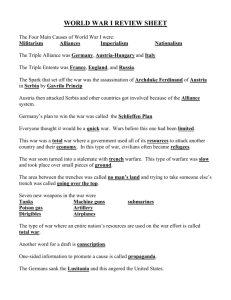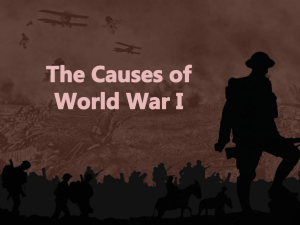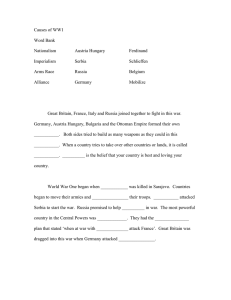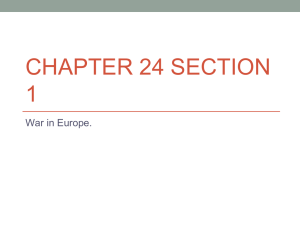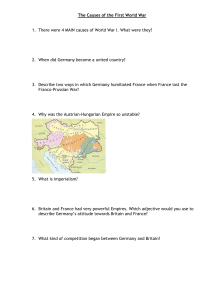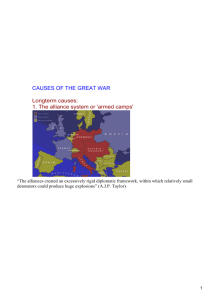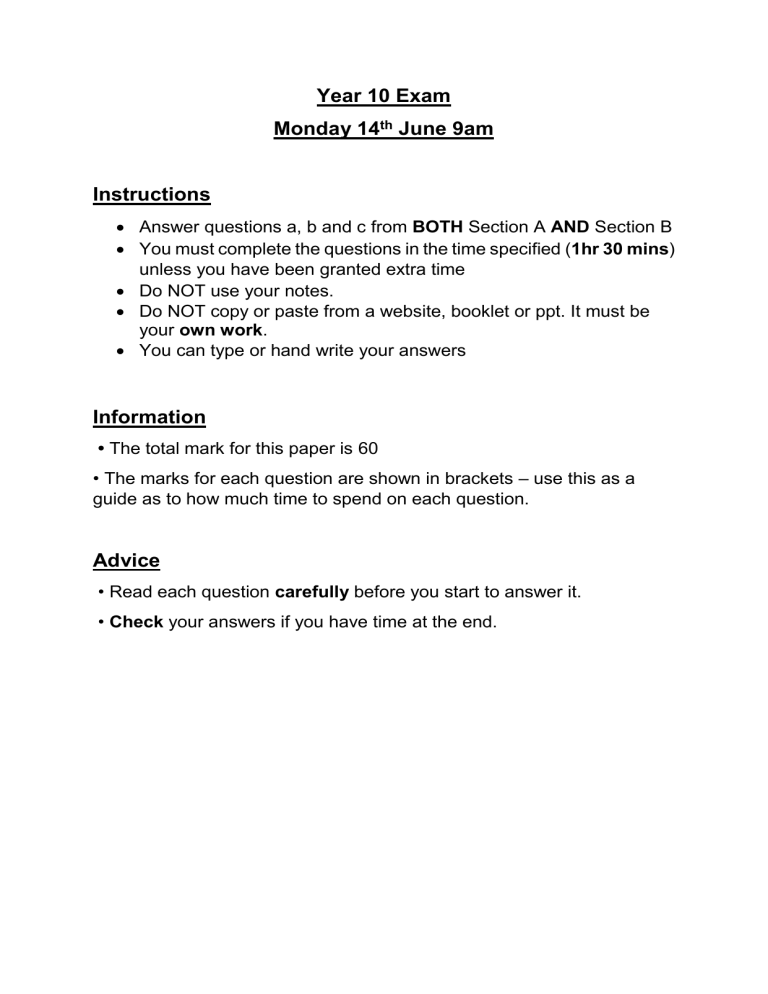
Year 10 Exam Monday 14th June 9am Instructions Answer questions a, b and c from BOTH Section A AND Section B You must complete the questions in the time specified (1hr 30 mins) unless you have been granted extra time Do NOT use your notes. Do NOT copy or paste from a website, booklet or ppt. It must be your own work. You can type or hand write your answers Information • The total mark for this paper is 60 • The marks for each question are shown in brackets – use this as a guide as to how much time to spend on each question. Advice • Read each question carefully before you start to answer it. • Check your answers if you have time at the end. Section A: Germany Development of Dictatorship, 19181945 Spend 45 minutes on this section Study Extract C. Extract C: From Germany 1858–1990, published in 2001. Hitler believed he could overthrow the Weimar government by leading a putsch. However, Hitler’s impatience, poor planning and poor organisation led to failure. He had overestimated support for an uprising. Crucially, Hitler could not rely on the total support of the Bavarian army. Moreover, Hitler had gone too far to be able to stop the putsch, having already worked his supporters up to fever-pitch excitement. What followed was a disaster for the Nazis. Sixteen Stormtroopers were killed, Hitler was sent to prison and the Nazi Party was banned. (a) What impression does the author give about the failure of the Munich Putsch? The impression the author gives us is that Hitler’s planning of the putsch was an utter disaster which led to extreme consequences. Not only were Sixteen Stormtroopers killed but Hitler himself was imprisoned and had the Nazi Party banned. The author says that “Hitler’s impatience, poor planning and poor organisation led to failure” and that he had “gone too far”. Overall, the author gives us a realistic and disapproving message. (b) Explain two effects of the work of Gustav Stresemann in Germany in the years 1923–29. (8) Gustav Stresemann became the Chancellor of Germany in August 1923. During the hyperinflation crisis in Germany. One of the effects was calling of the “Passive Resistance” of the German workers in the Ruhr. This helped German’s economy because goods were back in production and the Government could stop printing money to pay workers on strike. Another effect was Stresemann announced a new currency called the “Rentenmark”. This steadied Germany’s prices as they only a limited the number of “Rentenmark” to be printed causing the new money to increase its value again. This helped restore Germany’s economy. c) ‘The main reason that the Nazis faced little opposition in Germany was because of their use of propaganda and censorship.’ How far do you agree? Explain your answer You may use the following in your answer • Propaganda and censorship • Nazi achievements • You MUST use information of your own. • 16 marks The Nazi’s effectively became successful through propaganda. The propaganda was to manipulate peoples fear of uncertainty and instability. These messages varied from “Bread and Work” which was aimed at the working class and the fear of unemployment, to a “Mother and Child” poster portraying the Nazi ideals regarding women. Jews and communists also featured heavily in the Nazi’s propaganda as enemies of the German people. Joseph Goebbels was key to the Nazi use of the propaganda to increase their plea. Goebbels joined the Nazi party in 1924 and became “Gauleiter” in 1926. Goebbels used a combination of modern media, such as radio and films, and traditional campaigning tools such as newspapers and posters to reach as many people as possible. From this technique that he began to build an image of Hitler as a strong and sustainable leader for Germany. Section B: Origins and Course of WW1 Spend 45 minutes on this section (a) Describe TWO features of EITHER the Triple Entente OR the First Moroccan Crisis. (6) A feature of the Triple Entente was that it was an alliance formed by Great Britain, France and Russia in 1907 the alliance formed for the purpose of the protection of one another against the Triple Alliance of Germany, Austria-Hungary and Italy. Though each member of the Triple Entente joined for a different reason they were all collectively scared of Germany’s growing power. Another feature of the Triple Entente was to attempt to resolve a series of longrunning disputes over Persia, Afghanistan and Tibet and helped address British fear about the Baghdad railway, which would help German expansion near east. Study Sources A and B, then answer the question that follows. Source A: From a report written by a British official based in Serbia in 1909. Serbian nationalists firmly believe that Serbia should consist of all those people who share their culture and language. This is not confined to just those living within its current borders. Many Serbians demand the creation of a Greater Serbia which will unite together all those Serbians now living under Austrian, Hungarian and Turkish rule. All Serbian nationalists strongly believe that Bosnia must be part of this Greater Serbia. Source B: From a statement issued by a Serbian nationalist group in 1911. The annexation of Bosnia by Austria was only one attack which our enemies have made against Serbia. Many more will follow. Therefore, we must prepare thoroughly for war. Any future attack on us, like the take-over of Bosnia, must be resisted. In our new Serbian nation, everyone should be a soldier. We believe that Austria is our greatest enemy. In the future, it will be necessary for Serbia to fight Austria. b) How far does Source A support the evidence of Source B about the opinions of Serbian nationalists in the years 1909–14? Explain your answer. (8) Source B says “In our new Serbian nation” Source A agrees by saying “Many Serbians demand the creation of a Greater Serbia”. Source B declares “We believe that Austria is our greatest enemy” Source A replied by saying “Unite together all those Serbians now living under Austrian, Hungarian and Turkish rule.” Although Sources A and B mostly agree they disagree as Source B proclaims “Everyone should be a soldier” but Source A contradicts this by saying “Serbia should consist of all those people who share their culture and language.” Source A claims for peace whilst Source B prepares for war against Austria. Study Extract C and then answer the question that follows. c) Extract C suggests that Austria’s actions were the main reason for the outbreak of the First World War. How far do you agree with this interpretation? Use Extract C, Sources A and B and your own knowledge to explain your answer. (16) Extract C: From an article on the outbreak of the First World War, published in 2014. Austria’s actions were the main reason for the outbreak of the First World War. The Austrian government was determined to declare war on Serbia. It thought Serbia was behind the assassination of Franz Ferdinand. After securing Germany’s backing, Austria presented an ultimatum to Serbia which was made deliberately unacceptable. Both Austria and Germany knew that if Austria attacked Serbia, Russia would be likely to support Serbia. This could easily turn a local war in the Balkans into a European one. But Austria and Germany were willing to take this risk. Overall, I disagree with this interpretation that Austria was solely responsible for the outbreak of WW1 There is clear evidence in Extract C and Sources A and B that support the interpretation Austria did start a form of aggression against Serbia Extract C supports this by saying “Austrian government was determined to declare war on Serbia.” And proclaims that “This could easily turn a local war in the Balkans into a European one” and that they were “willing to take this risk.” Source A agrees with this interpretation by saying “unite together all those Serbians now living under Austrian, Hungarian and Turkish rule.” And goes on to say that “Serbian nationalists firmly believe that Serbia should consist of all those people who share their culture and language.” Source A agrees this interpretation that Serbia should be allowed to unite all Serbians living under Austrian rule and it is Austria’s fault for not letting Serbia do that. Source B agrees with this interpretation by saying “The annexation of Bosnia by Austria was only one attack which our enemies have made against Serbia. Many more will follow.” Source B contemplates that “We believe that Austria is our greatest enemy. In the future, it will be necessary for Serbia to fight Austria.” From my own knowledge I agree with this interpretation because Austria was the first to show aggression against Serbia and was careless enough too annex Bosnia angering Serbia making them concerned for their own safety. Extract C opposes by saying “Austria thought Serbia was behind the assassination of Franz Ferdinand.” Austria was in a misunderstanding and made aggressive moves to Serbia out of lack of communication. Source A disagrees by saying “Serbian nationalists firmly believe that Serbia should consist of all those people who share their culture and language. This is not confined to just those living within its current borders.” Source A wants peace between Austria and Serbia and only wishes to unites its people together. Source B challenges this by saying “The annexation of Bosnia by Austria was only one attack which our enemies have made against Serbia.” For it was only one attack Austria did not want war but wanted to warn Serbia if they stepped too far. Overall I partially agree with Extract C because yes Austria was the first to show any signs of aggression against Serbia by Annexing Bosnia but it was out of misunderstanding as Austria thought it was Serbia that assassinated Franz Ferninand.
